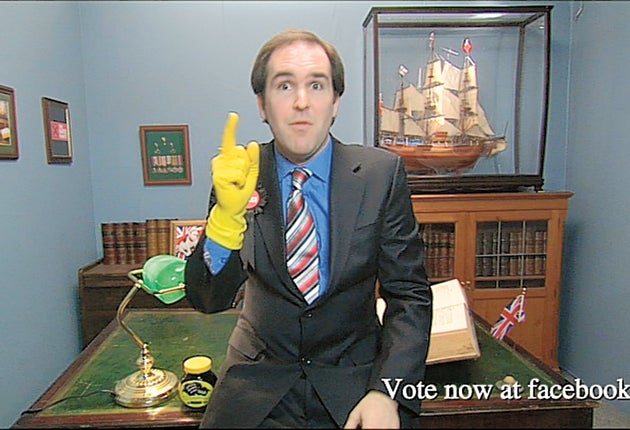Claire Beale On Advertising: This clash of the Saatchis is friends reunited

Your support helps us to tell the story
From reproductive rights to climate change to Big Tech, The Independent is on the ground when the story is developing. Whether it's investigating the financials of Elon Musk's pro-Trump PAC or producing our latest documentary, 'The A Word', which shines a light on the American women fighting for reproductive rights, we know how important it is to parse out the facts from the messaging.
At such a critical moment in US history, we need reporters on the ground. Your donation allows us to keep sending journalists to speak to both sides of the story.
The Independent is trusted by Americans across the entire political spectrum. And unlike many other quality news outlets, we choose not to lock Americans out of our reporting and analysis with paywalls. We believe quality journalism should be available to everyone, paid for by those who can afford it.
Your support makes all the difference.Only 24 days until the general election and already almost as much has been written about how the parties are advertising themselves as about what they might actually do if they win power.
Mostly, though, the run-up advertising has been as bland and disappointing as the policies themselves. Now we're in countdown, we're finally being served some bold advertising ideas and the knocking copy is knocking.
This has been dubbed the "social media" election. But the past week has seen the triumphant return of the battle bus, doorstep canvassing and, of course, the big, brash poster campaign. Because no matter how fashionable, practical and cost-effective social media electioneering is, it isn't photogenic. When was the last time you saw a three-column, full-colour picture of a tweet? On the other hand, a 96-sheet knee-in-the-groin poster assault on the opposition is guaranteed to make headlines.
And it's not just the bedrock strategies that are tried and tested. All three main parties have turned to the history books for their advertising support, too.
Labour's ad agency is Saatchi & Saatchi, which famously helped propel Thatcher to power in 1979 with Charles Saatchi's "Labour Isn't Working" poster. Of course the Saatchi team is a 21st-century one, led by one of adland's rare female creative talents, the perky and provocative Kate Stanners. And this time much of the agency's work is about soundbites and speeches, not just the bold political advertising punch that made it famous. But Labour has been particularly pleased with itself over its cheeky decision to hire Thatcher's old agency.
As for the original Saatchi team that worked with Thatcher all those decades ago, they were kicked out of their agency in the early 90s and launched rival shop M&C Saatchi. In a neat twist, the M&C crew were called back to the Tory front line by David Cameron last month. And though Charles Saatchi has since given up advertising and his brother Maurice is not involved with the new Tory account, M&C's veteran creative Jeremy Sinclair is rolling up his sleeves again for the Tory cause. And the Saatchi versus Saatchi battle has certainly added spice. It's particularly good sport for Saatchi & Saatchi's chief executive, Robert Senior, and his counterpart at M&C Saatchi, Moray MacLennan, who just happen to be extremely good pals, even when they find themselves on opposite sides of the political battle lines.
Naturally, though, the advertising war is more complicated than the neat headlines would suggest. The Tories insist that they are still working full throttle with another ad agency, Euro RSCG, whose global chief executive, David Jones, is thoroughly from the Cameron mould, all easy charm and smooth patter. Apparently the two Davids are good chums and meet regularly for cosy chit chats over strategy. Mind you, the triumphant return of M&C Saatchi on the Tory scene – and their immediate success with the anti-Brown posters with lines like, "I took billions from pensions, vote for me" – will have frozen the smiles for a while.
Meanwhile, the Lib Dems have also done their bit for reviving old adland relations. Their agency, Iris, is headed by European chief Paul Bainsfair, who once ran an ad agency with the Lib Dems communications advisor John Sharkey. The one-time business partners' first effort is the complex "Labservative" idea, but it's nice to see politics bringing people together.
Yes, this might be the first internet election, the first where Twitter, Facebook and YouTube are playing a central role. But old colleagues and track records and traditional media are the weapons that are really going to make the difference. And as tensions rise over the coming weeks, all the party leaders are going to need all the old friends they can muster.
Best in Show: Marmite (DDB London)
*DDB London's ads for Marmite have appeared in this slot several times over the last few years. They're always good. Now agency and client are turning election fever to their favour by holding their own poll.
There are only two parties in the Marmite vote-off: the Love [Marmite] Party and the Hate [Marmite] Party. But this ad campaign is not just a bit of clumsy opportunism. It's a nicely thought-through idea, with print ads and virals backed by a Marmite News Network website to keep you up to date with party political broadcasts from the two camps and Facebook groups offering support for the different manifestos.
There may even be some strategies here to teach the party professionals a thing or two.
Subscribe to Independent Premium to bookmark this article
Want to bookmark your favourite articles and stories to read or reference later? Start your Independent Premium subscription today.
Join our commenting forum
Join thought-provoking conversations, follow other Independent readers and see their replies
Comments